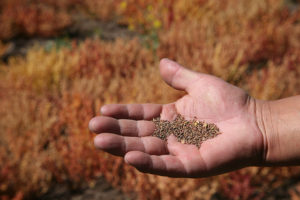
Bioversity International launched the “Trees for Seeds: Resilient forest restoration” initiative at the Global Landscapes Forum (GLF) in late August in Nairobi, Kenya.
Pardon the pun but hedging our bets with global land restoration is exactly what we need to be doing if we don’t want to bury billions of dollars in a failed investment.
On the last two days of August I participated in the GLF in Nairobi. This was an exciting meeting, not least because of the buzz around the African commitment to restoration through the African Forest Landscape Initiative (AFR100), and the very clear political will and private sector appetite for restoration – AFR100 is a country-led effort to bring 100 million hectares of deforested and degraded landscapes across Africa into restoration by 2030.
The rhetoric behind delivering large-scale restoration is compelling. Globally, degraded land costs about 10% of global gross domestic product (GDP) per year, while the benefits estimated in the billions of US dollars per year through improved ecosystem services, climate mitigation and improved productivity of degraded land.
Read also: FTA at GLF Nairobi: Faith in trees restored
The huge potential for AFR100 to contribute to a healthier, greener and more sustainable planet, are reasons to be happy. At the same time the growing pledges now at 100 million hectares for Africa, in the next 12 years, leaves one thinking “great, so how are we going to do this?” That’s a lot of land, a lot of trees and a lot of seeds.
Of course, the counting of hectares to be restored is pretty easy to do on paper. Delivering the sustainable development objectives from this restoration, on the other hand, requires planning, financing, and a clear idea of what this landscape restoration will look like on the ground.
On Aug. 28, the journal Nature also published an open access news article titled How to plant a trillion trees. That’s about one-third of the trees on our planet, or approximately 130 trees per person!
One of the critical barriers to restoration is having access to the seeds, and seedlings of the right tree species, of the right quality, that will be able to deliver multiple societal benefits, and contribute to multiple ecosystem services. This is the focus of the Trees for Seeds initiative (#Trees4Seeds) at Bioversity International, which was launched at the GLF. Watch the video of the launch, where distinguished panelists from Ghana and Cameroon joined us to discuss the significance of this topic for meeting their pledges under AFR100.
Watch: Trees for Seeds, a foundation for resilient restoration
What is the best way to plant trees? Well, Mother Nature is certainly among the best restoration practitioners. Natural regeneration of trees to fallow land is likely to be an important first port-of-call for many countries to meet the Bonn Challenge pledges.
Natural regeneration represents the least costly method of restoring degraded land. But, this does not automatically mean that regenerating forests or the trees on fallow lands will deliver the most pressing sustainable development needs such as poverty alleviation (SGD1) food security (SDG2), improved human health (SDG3), gender equality (SDG5), climate mitigation (SDG13) and biodiversity conservation (SDG15).
In degraded tropical landscapes, many of the most useful tree species may not be present in sufficient numbers, or may be growing far from the site designated for restoration for seed dispersal to deliver seeds naturally. Let’s remember many tropical tree species seeds are dispersed by animals (birds, bats or monkeys), often hunted out of these landscapes. This short video interview highlights the problems and approaches of the Trees4Seeds initiative.
In reality, nature is going to need a little help in many situations. This might be through planting trees as part of enrichment restoration, or through seeding degraded lands from drones, or planes. Whichever the delivery method, at the very basis is the need for seeds, seeds from a diverse range of species, and seeds of good quality. If we fail to address this as the foundation of resilient restoration, then I am afraid that our restoration efforts will be wasted. These landscapes will not be resilient to climate change, will not be resilient to novel pests and disease, and will not deliver SDGs.
There is a huge opportunity out there. Nowhere on earth is the diversity of native trees greater than in tropical and sub-tropical countries (home to the vast majority of more than 60,000 species of tree), where the returns on investment in restoration will be greatest. We have the chance to develop diversified restoration portfolios, using diverse species, which deliver multiple benefits, and can be resilient. This diversity offers novel business opportunities, where global food systems are currently lacking. Trees can be some of the most nutritionally important parts of our diet.
As shown by a recent paper by colleagues working on nutrition at Bioversity International, the more species you eat the greater your health. Also, some tropical trees are much better at locking up carbon than others, species that produce heavy dense wood might be slower growing but pack more carbon per hectare of land. Such species also offer opportunities to lock up carbon for longer, rather than just being used to generate fiber for waste paper.
Let’s not miss this opportunity. We have an urgent need to conserve the diversity of tropical trees so that we can use their genetic resources (seeds) for restoration. But we also need to invest in countries’ capacity to sustainably use this huge and valuable biological diversity to its full potential.
Join us at the next GLF in Bonn, Germany, on Dec. 1-2 to take the next steps in the Trees for Seeds initiative.
By Christopher Kettle, Science Domain Leader, Forest Genetic Resources and Restoration, Bioversity International. Originally published by Bioversity International.
This research is part of the CGIAR Research Program on Forests, Trees and Agroforestry (FTA) and is supported by CGIAR Trust Fund Donors.











